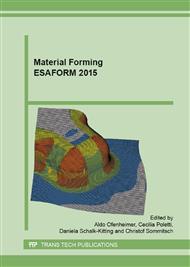p.15
p.21
p.27
p.32
p.38
p.47
p.53
p.59
p.65
Comparison of 15Cr-15Ni Austenitic Steel Cladding Tubes Obtained by HPTR Cold Pilgering or by Cold Drawing
Abstract:
Due to their high void swelling resistance, work-hardened titanium stabilized austenitic steels have been chosen as cladding material for sodium cooled fast reactor. In this study, HPTR cold pilgering process is compared to cold drawing at the last shaping step of the tube processing. The effects of the cold work accumulation and heat treatments are studied in connection with the microstructure (grain size), the hardness and the texture. The following results were found:- As larger amount of cold work can be applied by HPTR cold pilgering, a lower number of intermediate heat treatments are required. In addition, the bending of the tube is significantly reduced after each pass for this process allowing for a limitation of the straightening operations.- For both processes, optical micrographs show micrometric titanium carbide precipitates and the presence of deformation twins on a few grains on the final tube. A significant grain size refinement from ≈45 μm to ≈17 μm can be obtained by reducing annealing temperature from 1403K down to 1353K. For the latter, the precipitated mass fraction measured by selective dissolution of the alloy matrix is the largest, revealing a possible negative impact on swelling under irradiation.- Through-wall Vickers hardness profiles show an increase of the hardness at the outer diameter for HPTR cold pilgering whereas the hardness profile remains continuous for cold drawing. It is found that the Q-factor has an influence on these wall-thickness hardness profiles.- For each process, neutron diffraction measurements on finished tubes reveal two main fiber texture components 〈111〉 and 〈100〉 parallel to the tube axis with differences in their relative intensities.
Info:
Periodical:
Pages:
38-46
Citation:
Online since:
July 2015
Keywords:
Price:
Сopyright:
© 2015 Trans Tech Publications Ltd. All Rights Reserved
Share:
Citation:


